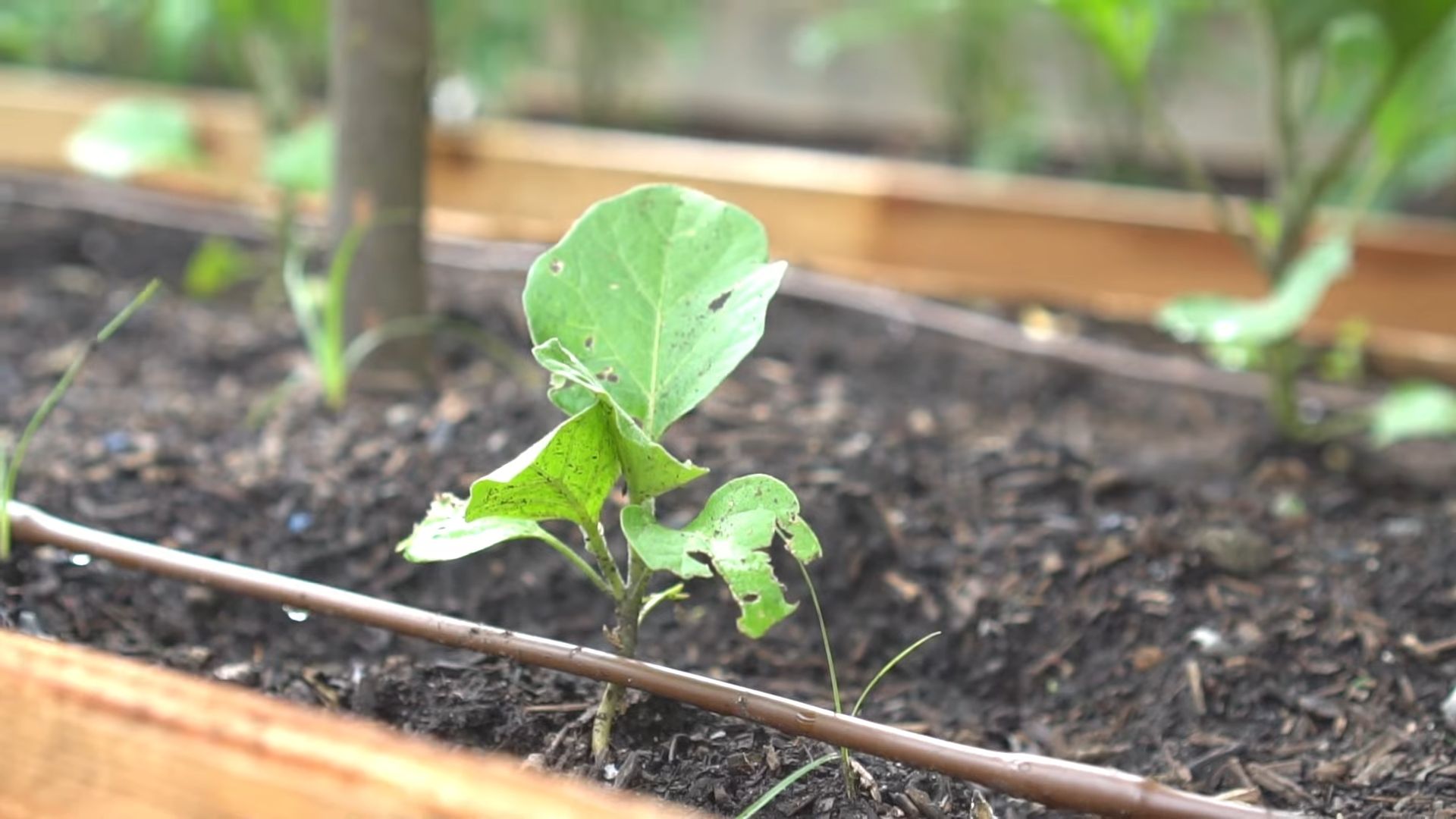Growing Eggplant Simple and Easy: Unlock the secrets to a bountiful harvest right in your backyard! Have you ever dreamed of plucking plump, glossy eggplants straight from your own garden? It’s more achievable than you think, and I’m here to guide you through the process with some simple and effective DIY tricks.
Eggplant, with its rich history tracing back to ancient Asia, has been a culinary staple for centuries. From the Mediterranean’s moussaka to Asia’s stir-fries, this versatile vegetable has graced tables worldwide. But you don’t need to be a seasoned chef to appreciate the joy of growing your own.
Many people shy away from growing eggplant, thinking it’s too difficult or requires a “green thumb.” But I’m here to tell you that’s simply not true! With the right knowledge and a few clever DIY hacks, growing eggplant simple and easy is within everyone’s reach. Imagine the satisfaction of serving a delicious eggplant parmesan made with ingredients you nurtured from seed to table. Plus, homegrown eggplants often taste far superior to store-bought ones, bursting with fresh, vibrant flavor.
This article will equip you with the essential tips and tricks to cultivate thriving eggplant plants, even if you’re a complete beginner. We’ll cover everything from seed starting to pest control, ensuring you enjoy a successful and rewarding gardening experience. So, grab your gardening gloves, and let’s get started!

Growing Eggplant: A Beginner’s Guide to Bountiful Harvests
Hey there, fellow gardening enthusiasts! I’m super excited to share my tried-and-true method for growing eggplants. Trust me, even if you’re a complete newbie, you can absolutely cultivate these beautiful, glossy fruits in your own backyard. It might seem intimidating at first, but with a little patience and these simple steps, you’ll be enjoying delicious eggplant dishes in no time. Let’s get started!
Choosing the Right Eggplant Variety
Before we even think about planting, it’s crucial to pick the right eggplant variety for your climate and space. There are so many options out there, from the classic large, purple ‘Black Beauty’ to the slender, Asian-style ‘Ichiban’ and even the adorable, round ‘Fairy Tale’ eggplant.
* Climate Considerations: If you live in a cooler climate with a shorter growing season, opt for early-maturing varieties like ‘Early Black Egg’ or ‘Dusky’. These will give you a better chance of harvesting before the first frost. For warmer climates, you have a wider range of choices.
* Space Requirements: Eggplants need space to grow, but some varieties are more compact than others. If you’re gardening in containers or a small space, look for bush-type varieties like ‘Patio Baby’ or ‘Hansel’.
* Personal Preference: Consider what you plan to do with your eggplants. If you love grilling, the larger varieties are perfect. For stir-fries, the Asian varieties are a great choice.
I personally love growing ‘Black Beauty’ because they are so versatile and produce a good yield. But don’t be afraid to experiment and find your own favorite!
Starting Eggplant Seeds Indoors (Recommended)
Eggplants have a long growing season, so starting them indoors is highly recommended, especially if you live in a cooler climate. This gives them a head start and ensures you’ll have plenty of time to harvest.
What You’ll Need:
* Eggplant seeds
* Seed starting trays or small pots
* Seed starting mix
* Grow lights (optional, but highly recommended)
* Heat mat (optional, but helpful)
* Spray bottle
Step-by-Step Instructions:
1. Sow the Seeds: Fill your seed starting trays or pots with seed starting mix. Moisten the mix thoroughly with a spray bottle. Sow the eggplant seeds about ¼ inch deep, placing 2-3 seeds per cell or pot. Gently cover the seeds with more mix and lightly water again.
2. Provide Warmth and Light: Eggplant seeds need warmth to germinate. Place the trays or pots on a heat mat, if you have one. This will help maintain a soil temperature of around 80-85°F (27-29°C). Place the trays under grow lights, or in a very sunny window. If using grow lights, keep them about 2-3 inches above the soil surface and provide 14-16 hours of light per day.
3. Keep the Soil Moist: Keep the soil consistently moist, but not soggy. Use a spray bottle to gently water the seedlings as needed. Avoid overwatering, which can lead to damping off, a fungal disease that can kill young seedlings.
4. Thin the Seedlings: Once the seedlings have emerged and have a couple of true leaves (the second set of leaves), thin them to one seedling per cell or pot. Choose the strongest, healthiest-looking seedling and snip off the others at the soil line.
5. Harden Off the Seedlings: About a week or two before you plan to transplant the seedlings outdoors, you’ll need to harden them off. This process gradually acclimates the seedlings to outdoor conditions. Start by placing the seedlings outdoors in a sheltered location for an hour or two each day, gradually increasing the amount of time they spend outside. Protect them from direct sunlight and strong winds.
Preparing the Garden Bed
While your eggplant seedlings are growing indoors, it’s time to prepare the garden bed. Eggplants need well-drained soil that is rich in organic matter.
What You’ll Need:
* Garden fork or tiller
* Compost or well-rotted manure
* All-purpose fertilizer (optional)
* Gardening gloves
Step-by-Step Instructions:
1. Choose a Sunny Location: Eggplants need at least 6-8 hours of direct sunlight per day. Choose a location in your garden that receives plenty of sun.
2. Prepare the Soil: Use a garden fork or tiller to loosen the soil to a depth of at least 12 inches. Remove any rocks, weeds, or debris.
3. Amend the Soil: Incorporate a generous amount of compost or well-rotted manure into the soil. This will improve drainage, add nutrients, and help retain moisture. I usually add about 2-3 inches of compost to my garden bed.
4. Fertilize (Optional): If your soil is particularly poor, you can add an all-purpose fertilizer according to the package directions. I prefer to use organic fertilizers.
5. Create Raised Beds (Optional): If your soil is heavy clay or poorly drained, consider creating raised beds. This will improve drainage and warm the soil more quickly in the spring.
Transplanting Eggplant Seedlings Outdoors
Once the danger of frost has passed and the soil has warmed up, it’s time to transplant your eggplant seedlings outdoors.
What You’ll Need:
* Eggplant seedlings
* Trowel
* Watering can or hose
* Mulch (optional)
* Plant markers
Step-by-Step Instructions:
1. Choose a Cloudy Day: Transplanting on a cloudy day will help reduce stress on the seedlings.
2. Dig Holes: Dig holes that are slightly larger than the root balls of the seedlings. Space the holes about 18-24 inches apart.
3. Remove Seedlings from Pots: Gently remove the seedlings from their pots, being careful not to damage the roots. If the roots are tightly bound, gently loosen them with your fingers.
4. Plant the Seedlings: Place the seedlings in the holes and backfill with soil. Gently firm the soil around the base of the plants.
5. Water Thoroughly: Water the seedlings thoroughly after planting.
6. Mulch (Optional): Apply a layer of mulch around the plants to help retain moisture, suppress weeds, and regulate soil temperature. I like to use straw or shredded leaves.
7. Add Plant Markers: Label each plant with a plant marker so you know what variety you’re growing.
Caring for Your Eggplant Plants
Once your eggplant plants are in the ground, it’s important to provide them with proper care to ensure a bountiful harvest.
Watering:
Eggplants need consistent moisture, especially during hot, dry weather. Water deeply and regularly, aiming to keep the soil consistently moist but not soggy. Avoid overhead watering, which can promote fungal diseases. I usually water my eggplants every 2-3 days, depending on the weather.
Fertilizing:
Eggplants are heavy feeders and benefit from regular fertilization. Side-dress the plants with compost or an organic fertilizer every 2-3 weeks. You can also use a liquid fertilizer, such as fish emulsion or seaweed extract, diluted according to the package directions.
Pruning:
Pruning can help improve air circulation and encourage fruit production. Remove any suckers (small shoots that grow from the base of the plant) and any yellowing or diseased leaves. You can also pinch off the tips of the branches to encourage bushier growth.
Pest and Disease Control:
Eggplants are susceptible to a few common pests and diseases, including aphids, flea beetles, and blossom-end rot.
* Aphids: These tiny insects can suck the sap from the leaves, causing them to curl and distort. You can control aphids by spraying them with a strong stream of water or by using insecticidal soap.
* Flea Beetles: These small, jumping beetles can chew holes in the leaves. You can control flea beetles by covering the plants with row covers or by using insecticidal soap.
* Blossom-End Rot: This condition is caused by a calcium deficiency and results in dark, sunken spots on the bottom of the fruit. To prevent blossom-end rot, make sure your soil is well-drained and that you’re providing your plants with consistent moisture. You can also add calcium to the soil by incorporating bone meal or crushed eggshells.
I always try to use organic methods for pest and disease control whenever possible.
Staking:
As your eggplant plants grow, they may need to be staked to support the weight of the fruit. Use sturdy stakes and tie the plants loosely to the stakes with soft twine.
Harvesting Your Eggplants
The moment you’ve been waiting for! Eggplants are typically ready to harvest about 60-80 days after transplanting

Conclusion
So, there you have it! Growing eggplant doesn’t have to be a daunting task reserved for seasoned gardeners. With a little patience, the right approach, and this simple DIY trick, you can cultivate your own thriving eggplant patch, bursting with beautiful, glossy fruits ready for your favorite recipes. This method, focusing on [mention the specific DIY trick from the article, e.g., “consistent watering and strategic pruning”], truly unlocks the potential of your eggplant plants, leading to a more abundant and higher-quality harvest.
Why is this a must-try? Because it addresses the most common challenges faced by eggplant growers: inconsistent fruit production, susceptibility to pests, and overall plant health. By implementing this DIY trick, you’re not just growing eggplants; you’re creating an optimal environment for them to flourish. Imagine the satisfaction of harvesting your own organically grown eggplants, knowing you nurtured them from seedling to table.
But don’t stop there! Feel free to experiment and adapt this technique to your specific garden conditions. For instance, if you live in a particularly hot climate, consider providing your eggplants with some afternoon shade. You could also try companion planting with basil or marigolds to deter pests naturally. Another variation is to experiment with different types of organic fertilizers to see which yields the best results for your soil. Perhaps you’ll discover that adding a specific type of compost tea gives your eggplants an extra boost. The possibilities are endless!
Growing eggplant is a rewarding experience, and this DIY trick is your key to unlocking its full potential. We’re confident that you’ll see a significant improvement in your eggplant yield and overall plant health.
Now, it’s your turn! We encourage you to give this DIY trick a try and share your experiences with us. Did it work for you? Did you make any modifications? What challenges did you face, and how did you overcome them? We’re eager to hear your stories and learn from your insights. Share your photos and tips in the comments section below. Let’s build a community of eggplant enthusiasts, sharing our knowledge and helping each other grow the best eggplants possible! Happy gardening!
Frequently Asked Questions (FAQ)
What exactly is the DIY trick you’re referring to?
This article focuses on the importance of [mention the specific DIY trick again, e.g., “consistent watering and strategic pruning”] for successful eggplant cultivation. Consistent watering ensures the plants receive the necessary hydration for fruit development, preventing blossom end rot and other water-related issues. Strategic pruning, on the other hand, promotes airflow, reduces the risk of fungal diseases, and encourages the plant to focus its energy on producing fewer, but larger and healthier, eggplants. We also emphasize the importance of soil health and proper fertilization.
How often should I water my eggplant plants?
Watering frequency depends on your climate and soil type. Generally, eggplants need about 1-2 inches of water per week. Check the soil moisture regularly by sticking your finger about an inch deep into the soil. If it feels dry, it’s time to water. In hot, dry weather, you may need to water daily. Use a soaker hose or drip irrigation to water deeply and evenly, avoiding wetting the foliage, which can encourage fungal diseases. Early morning watering is generally recommended.
What kind of fertilizer should I use for eggplants?
Eggplants are heavy feeders and benefit from regular fertilization. Start with a balanced fertilizer (e.g., 10-10-10) at planting time. Once the plants start to flower and fruit, switch to a fertilizer higher in phosphorus and potassium (e.g., 5-10-10) to promote fruit development. Organic options like compost tea, bone meal, and fish emulsion are also excellent choices. Avoid over-fertilizing, as this can lead to excessive foliage growth at the expense of fruit production. Side-dress your plants with fertilizer every 4-6 weeks during the growing season.
How do I prune my eggplant plants?
Pruning eggplants helps improve airflow, reduce disease risk, and encourage fruit production. Remove suckers (small shoots that grow from the base of the plant) to direct the plant’s energy towards the main stem and fruit. As the plant grows, remove any yellowing or damaged leaves. Once the plant starts producing fruit, you can also prune away some of the lower leaves to improve airflow around the fruits. If you have too many fruits developing at once, you can thin them out to allow the remaining fruits to grow larger.
My eggplant leaves are turning yellow. What’s wrong?
Yellowing leaves can indicate several problems. Overwatering or underwatering are common culprits. Check the soil moisture and adjust your watering accordingly. Nutrient deficiencies can also cause yellowing leaves. Make sure you’re fertilizing your plants regularly with a balanced fertilizer. Pests like aphids or spider mites can also cause leaf damage and yellowing. Inspect your plants carefully for signs of pests and treat them accordingly. Finally, fungal diseases can also cause yellowing leaves. Ensure good airflow around your plants and avoid wetting the foliage when watering.
My eggplants are developing blossom end rot. What can I do?
Blossom end rot is caused by a calcium deficiency, usually due to inconsistent watering. Ensure your plants receive consistent moisture, especially during fruit development. You can also add calcium to the soil by incorporating bone meal or crushed eggshells. Avoid using fertilizers high in nitrogen, as this can interfere with calcium uptake. Foliar sprays containing calcium can also help correct the problem.
What are some common pests that attack eggplants, and how can I control them?
Common eggplant pests include aphids, flea beetles, spider mites, and tomato hornworms. Aphids can be controlled with insecticidal soap or neem oil. Flea beetles can be deterred by using row covers or applying diatomaceous earth. Spider mites can be controlled with miticides or by increasing humidity around the plants. Tomato hornworms can be handpicked off the plants. Companion planting with basil or marigolds can also help deter pests.
How long does it take for eggplants to mature?
Eggplants typically take 60-80 days to mature from transplanting. The exact time depends on the variety and growing conditions. You’ll know your eggplants are ready to harvest when they are glossy, firm, and have reached their mature size and color. Gently press the skin; if it springs back, it’s ready to harvest. Use a sharp knife or pruning shears to cut the fruit from the plant, leaving a small stem attached.
Can I grow eggplants in containers?
Yes, eggplants can be successfully grown in containers. Choose a large container (at least 5 gallons) with good drainage. Use a high-quality potting mix and fertilize regularly. Container-grown eggplants may need more frequent watering than those grown in the ground. Select compact or dwarf varieties for container gardening.
What are some good companion plants for eggplants?
Good companion plants for eggplants include basil, marigolds, thyme, oregano, and peppers. Basil helps repel pests like aphids and whiteflies. Marigolds also deter pests and attract beneficial insects. Thyme and oregano can help improve the flavor of eggplants. Peppers are in the same family as eggplants and can benefit from similar growing conditions. Avoid planting eggplants near fennel, as it can inhibit their growth.





Leave a Comment